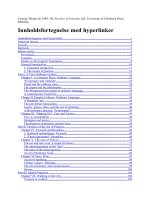university of california press nbc americas network aug 2007
Bạn đang xem bản rút gọn của tài liệu. Xem và tải ngay bản đầy đủ của tài liệu tại đây (1.23 MB, 376 trang )
NBC
NBC
America’s Network
MICHELE HILMES, Editor
MICHAEL HENRY
Library of American Broadcasting, Photo Editor
UNIVERSITY OF CALIFORNIA PRESS
Berkeley Los Angeles London
University of California Press, one of the most distinguished university
presses in the United States, enriches lives around the world by advancing
scholarship in the humanities, social sciences, and natural sciences. Its
activities are supported by the UC Press Foundation and by philanthropic
contributions from individuals and institutions. For more information, visit
www.ucpress.edu.
University of California Press
Berkeley and Los Angeles, California
University of California Press, Ltd.
London, England
© 2007 by The Regents of the University of California
Library of Congress Cataloging-in-Publication Data
NBC : America’s network / Michele Hilmes, editor ; Michael Henry,
Library of American Broadcasting, photo editor.
p. cm.
Includes bibliographical references and index.
isbn-13: 978-0-520-25079-6 (cloth : alk. paper)
isbn-13: 978-0-520-25081-9 ( pbk. : alk. paper)
1. National Broadcasting Company, inc. I. Hilmes, Michele, 1953–
II. Henry, Michael (Michael Lowell)
pn1992.92.n37n33 2007
384.55'06573—dc22 2006027331
Manufactured in the United States of America
15 14 13 12 11 10 09 08 07 06
10987654321
This book is printed on New Leaf EcoBook 50, a 100% recycled fiber
of which 50% is de-inked post-consumer waste, processed chlorine-
free. EcoBook 50 is acid-free and meets the minimum requirements
of ansi/astm d5634–01 (Permanence of Paper).
List of Illustrations ix
Acknowledgments xi
PART ONE • Broadcasting Begins, 1919–38
Introduction to Part One
Michele Hilmes 3
1 NBC and the Network Idea: Defining the “American System”
Michele Hilmes 7
2 “Always in Friendly Competition”: NBC and CBS
in the First Decade of National Broadcasting
Michael J. Socolow 25
3 Programming in the Public Interest: America’s Town Meeting of the Air
David Goodman 44
4 Regulating Class Conflict on the Air: NBC’s Relationship
with Business and Organized Labor
Elizabeth Fones-Wolf and Nathan Godfried 61
PART TWO •
Transitional Decades, 1938–60
Introduction to Part Two
Michele Hilmes 81
5 Breaking Chains: NBC and the FCC Network Inquiry, 1938–43
Christopher H. Sterling 85
Contents
6 Why Sarnoª Slept: NBC and the Holocaust
David Weinstein 98
7 Employment and Blue Pencils: NBC, Race, and Representation,
1926–55
Murray Forman 117
8 NBC, J. Walter Thompson, and the Struggle for Control of
Television Programming, 1946–58
Mike Mashon 135
9 Talent Raids and Package Deals: NBC Loses Its Leadership
in the 1950s
Douglas Gomery 153
PART THREE • NBC and the Classic Network System, 1960–85
Introduction to Part Three
Michele Hilmes 171
10 NBC News Documentary: “Intelligent Interpretation”
in a Cold War Context
Michael Curtin 175
11 What Closes on Saturday Night: NBC and Satire
Jeªrey S. Miller 192
12 The Little Program That Could: The Relationship between NBC
and Star Trek
Máire Messenger Davies and Roberta Pearson 209
13 Sex as a Weapon: Programming Sexuality in the 1970s
Elana Levine 224
14 Saturday Morning Children’s Programs on NBC, 1975– 2006:
A Case Study of Self-Regulation
Karen Hill-Scott and Horst Stipp 240
PART FOUR • NBC in the Digital Age, 1985 to the Present
Introduction to Part Four
Michele Hilmes 259
15 Must-See TV: NBC’s Dominant Decades
Amanda D. Lotz 261
16 Creating the Twenty-first-Century Television Network:
NBC in the Age of Media Conglomerates
Christopher Anderson 275
17 Life without Friends: NBC’s Programming Strategies in an Age of
Media Clutter, Media Conglomeration, and TiVo
Kevin S. Sandler 291
18 Network Nation: Writing Broadcasting History as Cultural History
Michele Hilmes and Shawn VanCour 308
NBC Time Line 323
Bibliography 331
Notes on Contributors 343
Index 347
2. Bertha Brainard, NBC’s first director of commercial programming 18
3. John Royal, NBC’s first vice president of programming, 1930 33
4. On the stage of America’s Town Meeting of the Air 46
5. Hans V. Kaltenborn, controversial news commentator 71
6. FCC chair James Lawrence Fly addressing NBC Blue a‹liates, 1942 93
7. David Sarnoª with Louis Finkelstein, producer of The Eternal Light series
in the 1950s 110
8. Nat King Cole on stage with Betty Hutton, December 1957 131
9. On the set of Kraft Television Theatre, March 1951 141
10. Lew Wasserman, NBC’s secret weapon in its war against CBS in the 1950s
and 1960s 163
11. Robert W. Kintner, NBC president and self-avowed news junkie 178
12. Singer/songwriter Nancy Ames on That Was the Week That Was, 1964 197
13. William Shatner, DeForest Kelley, and Leonard Nimoy
on the set of Star Trek, 1966 215
14. Paul Klein, vice president of programming at NBC from 1976 to 1979 230
15. Phyllis Tucker-Vinson, vice president of children’s programming, 1980s 248
16. Brandon Tartikoª, president of NBC’s entertainment division from
1980 to 1990, with Bill Cosby in 1985 265
17. Robert C. Wright, president and chief executive o‹cer, 1995 277
Illustrations
ix
the authors of the chapters, whose expertise, hard work, determined research, bril-
liant insights, patience, and persistence made this volume what it is. I am very proud
to bring their work together into a first attempt to sketch out a cultural history of
one of the major social institutions of the twentieth century, the National Broad-
casting Company.
Special thanks must go to Michael Henry of the Library of American Broad-
casting (LAB) for serving as photo editor for the volume. Thanks, too, to Douglas
Gomery, resident scholar at the LAB, for his assistance in this project.
Mary Francis at the University of California Press provided steady support and
encouragement throughout the process of bringing this book to publication. I am
grateful to the anonymous reviewers for their insightful comments on the volume
in its early stages, and for their words of praise for the admittedly large and com-
plex undertaking of comprising the history of a network in one small volume.
Thanks also to those within the NBC establishment who supported this project
from the beginning, especially Horst Stipp, senior vice president for primary and
strategic research, who coauthored a chapter with Karen Hill-Scott, a frequent con-
sultant to NBC in the field of children’s programming. William Bartlett, vice pres-
ident of executive communications at NBC, took notice of the project early on and
sent me copies of the recent NBC publications Brought to You in Living Color and Con-
nections: Reflections on 60 Years of Broadcasting, both valuable histories undertaken by
the network itself, along with many helpful comments.
Finally, thanks must go to the archivists of the Wisconsin Historical Society, the
Wisconsin Center for Film and Theater Research, and the Library of Congress (as
well as all of those mentioned in the book’s final chapter); without their eªorts of
collecting, organizing, and preserving the important documents of NBC history,
most of these chapters could not have been written. In particular, I would like to
Acknowledgments
xi
mention Peter Gottlieb, Harry Miller, Maxine Flexner-Ducey, and Dorinda Hart-
mann as those whose assistance and support over the years have contributed greatly
to historical scholarship both here and in many other publications.
It is my fondest hope that the publication of this volume on NBC’s history will
inspire those who have in their keeping the still-inaccessible papers of the other
two major U.S. networks, ABC and CBS, to take steps to make those vitally im-
portant documents available to the public and to future generations of historians.
XII ACKNOWLEDGMENTS
PART ONE
Broadcasting Begins
1919–38
heaval in the United States, and indeed across the globe. Immigration, nativism, World
War I, the newfound power of women, migration from farms to cities, the growth
and problems of urban life, and a growing popular culture challenged nineteenth-
century Progressive notions of assimilation and control. Entertainment industries
like publishing, advertising, sports, movies, and vaudeville rose up to amuse, inform,
cajole, and educate the increasingly polyglot breed of Americans. A new kind of
popular culture developed at the grassroots level that many, especially the estab-
lished elites, feared and resisted. Mass communication began to be recognized as
a powerful new social phenomenon in an atmosphere of expanding democracy and
social instability.
The advent of radio drew on and aªected all these trends. Far from arriving as
a finished, uncontroversial technology that could be easily adopted by existing struc-
tures and hierarchies, radio stirred up conflicts, oªered competing uses, provoked
struggles over whose interests would prevail, and raised fears about the dangerous
cultural forces that might be unleashed by this invisible medium of connection and
communication. Out of these many forces radio broadcasting arose as a vital and
necessary participant in the American experience. In chapter 1, “NBC and the Net-
work Idea: Defining the ‘American System,’” Michele Hilmes places NBC in the
context of these large social, political, and cultural forces and shows the role played
by America’s first network in building up the United States’ unique system of com-
mercial network broadcasting.
In the period between the formation of RCA in 1919 and the founding of NBC
in 1926, radio broadcasting emerged from its previous domain in the garages and
attics of the amateurs and became a truly American social practice. Joining the so-
cial upheavals and disturbances of the Jazz Age, a time of rising a›uence, increasing
social tensions, technological advancement, and cultural experimentation, radio
Introduction to Part One
Broadcasting Begins, 1919–38
MICHELE HILMES
3
added its own unique voice to the mix. New institutions arose to address and con-
trol the growing business of radio. Though many U.S. governmental structures were
similar to those in other nations, the United States, significantly alone among the
major nations of the world, chose to entrust its rapidly growing broadcasting sys-
tem to major private corporations rather than to the state. The rise of the com-
mercial network represented America’s major contribution to broadcast industry
and culture. As it became important in people’s everyday lives, radio also attracted
serious debate. How should such a powerful new medium be controlled and shaped
to best serve the public interest of all Americans? How could its threatening as-
pects be contained and its promises be developed? Over the next decade, Ameri-
cans would strive to provide answers to these questions and in so doing would build
one of the largest and most successful broadcasting systems in the world.
Yet the industry itself was not a unified and monolithic enterprise. Though NBC
and CBS quickly became the two major players, exerting strong oligopolistic con-
trol over radio broadcasting in the United States, they also competed with each
other and with the ever-more-powerful forces of the advertising industry. In chap-
ter 2, “‘Always in Friendly Competition’: NBC and CBS in the First Decade of
National Broadcasting,” Michael J. Socolow traces the productive rivalry between
the two major U.S. broadcasting networks. Advertising agencies began to domi-
nate radio program production and often struggled with the networks for control
over content. Combined, the radio networks, the advertising agencies, and the taken-
for-granted American public created what some have called the golden age of U.S.
radio broadcasting. However, forces arguing for radio to be constructed as a public
service medium also ensured that the Communications Act of 1934, which created
the Federal Communications Commission, would oversee the nascent medium with
an eye toward the public interest. “Sustaining” programs, produced by the networks
without sponsorship, provided education, religious programming, cultural events,
and public aªairs discussions. David Goodman discusses the evolution of this par-
ticular program form in chapter 3, “Programming in the Public Interest: America’s
Town Meeting of the Air.” Yet as his chapter demonstrates, race and ethnicity remained
trouble spots for American radio. Many groups remained outside radio’s emergent
public sphere, including the voice of America’s rising labor movement, described
by Elizabeth Fones-Wolf and Nathan Godfried in chapter 4, “Regulating Class
Conflict on the Air: NBC’s Relationship with Business and Organized Labor.”
From a collection of individual stations oªering an eccentric mix of local en-
tertainments, radio had grown by 1938 into an enormously profitable industry and
a central focus of American life. Advertising agencies, networks, and stations, with
a heavy dose of Hollywood, created unique new forms of entertainment, infor-
mation, and expression. Though primarily intended to sell consumer goods, the
avenues of innovation opened up by this amazingly successful medium allowed a
variety of programs, genres, stars, and audiences to emerge that spoke to the hopes,
fears, and desires of the American public. New organizations like the National As-
sociation of Broadcasters sprang up to lobby and speak for the new industry, and
4 BROADCASTING BEGINS
trade journals such as Broadcasting and Sponsor were initiated to serve them (and serve
historians of the medium today). Ratings systems were devised so that advertisers
could begin to understand this new creature, the radio public, and fan magazines
rose up to cater to the audience’s insatiable interest in their new radio friends. By
1937, 74 percent of America’s households owned at least one radio set, and radio
listening occupied on average more than 4.5 hours per day. The American broad-
casting network had emerged as an institutional and cultural form central to na-
tional identity and American life.
INTRODUCTION TO PART ONE 5
scarcely give it any thought, lays out the three factors crucial to understanding not
only how NBC came to be but also how broadcasting emerged as one of our pri-
mary engines of cultural production around the globe.
1
First, national: when RCA
announced the formation of its new radio “chain” in 1926, it introduced the first
medium that could, through its local stations, connect the scattered and disparate
communities of a vast nation simultaneously and address the nation as a whole. Thus
radio could become a powerful means of creating and defining a national public,
sorely needed in those nation-building years between the two world wars.
Second, broadcasting: this word was coined to denote a new form of commu-
nication that emerged in the early 1920s, one that emanated invisibly from a cen-
tral source and passed with ease through not only physical but social and cultural
barriers to reach listeners as private individuals in their homes. More accessible,
more exotic (where did that distant station come from?), yet more intimate than
any former medium, it created new forms of community and new modes of cre-
ative expression.
Third, company: In the United States, unlike most of the rest of the world, broad-
casting would develop as a primarily privately owned enterprise, a business re-
sponding to market conditions rather than an organ of the state or a public service
institution. Yet its power and centrality to national interests meant that it would
also come under closer scrutiny and accept the basic compromise of government
regulatory oversight to a far greater extent than other media, even in the United
States with its First Amendment protections. These three factors—the accessibil-
ity and simultaneity of broadcasting, its unique capacity to link a nation and con-
struct a feeling of national identity, and the private ownership that led quickly to
advertising as an economic base—defined American broadcasting as a system some-
times imitated, sometimes reviled, around the world.
1
NBC and the Network Idea
Defining the “American System”
MICHELE HILMES
7
NBC was the first to put the three together. It positioned itself as “America’s
network,” just as the British Broadcasting Company (BBC) was Britain’s network
and as other nations would soon form national networks, even though by contrast
NBC would remain a private, not a public, corporation. Soon, in the national spirit
of commercial competition, it would be joined by its closest rival, CBS. This chap-
ter will trace the origins of the commercial network system of broadcasting as
worked out by NBC and its parent company RCA in the 1920s and 1930s, looking
at the essential tensions that drove its growth and the cultural results of its pioneering
eªorts. American radio negotiated a space for itself between principles of social
diversity and cultural standardization, between forces of national integration and
local independence, and between First Amendment–protected freedoms and the
need for regulatory control. These tensions, often reductively articulated as a conflict
between radio’s public service responsibilities and its commercial economic base,
resulted in the a‹liate/network structure and the system of sustaining and spon-
sored programs pioneered by NBC in the 1920s and 1930s. This particular com-
promise was unique to the United States and represents the central innovation of
the American system.
Chaos and Control
The story begins in the United States in the early decades of the twentieth century.
By 1917, the year that the United States entered World War I, amateur experi-
mentation with the wireless transmission of Morse-coded messages had already
reached a fairly sophisticated level of organization. Groups like the American Ra-
dio Relay League had formed, organizing networks, holding yearly meetings, and
devising a philosophy of what they called “citizens’ radio”: a vision of wireless broad-
casting open to all, each person both a sender and a receiver of messages, untram-
meled by either government restrictions or business considerations. Unlike the coun-
tries of Europe, at war since 1914 and still settling tense political conditions in the
early 1920s, the United States allowed and even encouraged active amateur ex-
perimentation and growth, shutting amateur stations down only from 1917 to 1919.
The war motivated rapid development of wireless technology, as well as training
of thousands of young men and women as wireless operators, many of whom would
pioneer radio broadcasting after the war as coded signals gave way to speech and
music over the air (S. Douglas 1987, 1999; Hilmes 1997).
Among these amateurs was a young Russian Jewish immigrant named David
Sarnoª, who by 1916 was already employed by the leading radio company oper-
ating in the United States, American Marconi, owned by its British parent corpo-
ration. Much has been made of Sarnoª ’s famous “radio music box” memo, which
may have been written that year, in which he suggested that radio might become
a popular means of listening to music carried invisibly over the airwaves into the
home. In fact he was only one of many amateurs and experimenters already put-
8 BROADCASTING BEGINS
ting such ideas into eªect nightly in garages and attics across the nation.
2
He was
uniquely placed to implement the notion, however, and it seems likely that his en-
thusiastic participation in the amateur free-for-all of the postwar years influenced
his understanding of the medium in many profound ways.
Sarnoª ’s immigrant origins point to another important factor in radio’s devel-
oping role in U.S. society. Immigration to the United States had increased steadily
through the turn of the century, reaching a peak in 1920, when nearly 35 percent
of the U.S. population either had been born in a foreign country or had at least
one foreign-born parent. In many large industrialized U.S. cities, that proportion
exceeded 50 percent (Dinnerstein and Reimers 1975, 40). The wave of immigra-
tion of the 1860s through the 1920s brought, not the Anglo Saxon and Northern
European Protestant settlers of the early period, who had tended to settle in rural
areas on independent farms in the best Jeªersonian tradition, but shiploads of eco-
nomic and political refugees from the “less civilized,” poorer, mostly eastern and
southern parts of Europe—Ireland, Italy, Poland, and the Balkans. The majority
of these immigrants were Roman Catholics and Jews, crowding into tenements in
the nation’s exploding and expanding cities. Fears of cultural disintegration and
NBC AND THE NETWORK IDEA 9
FIG. 1 David Sarnoª at his desk at NBC headquarters, September 1941. (Library of American
Broadcasting)
[To view this image, refer to
the print version of this title.]
lack of national cohesion began to circulate. How could the United States assimi-
late these swarming, disparate hordes? How could an American national identity
be maintained in the face of this overwhelming diversity?
Most social theorists of the day agreed that communication was essential and
that the expanding arena of popular media and entertainment, if properly super-
vised, could draw diverse populations into the social order; without such supervi-
sion, cultural chaos could spin out of control. In addition, experience with propa-
ganda during the First World War had left the nation wary of the power that media
oªered the state and powerful groups and even more suspicious of the dangerous
political currents swirling around on the street level during this tumultuous postwar
period. Radio both promised a solution to these problems and threatened to exac-
erbate them. From the beginning, however, it was clear that issues of national iden-
tity and social control, in tension with traditional American values of diversity and
freedom of expression, were too important to be left to chance, or the market, alone.
The Local and the National
Many Americans believed that the government, most likely the Department of the
Navy, would need to take charge of the new medium; others deplored the amount
of government intervention into private life that had occurred during the war and
were determined that radio should remain in private hands. One important com-
promise was reached in March 1919, when the General Electric Corporation (GE),
a leader in radio technology, negotiated to sell all rights to the important Alexan-
derson alternator to the British Marconi Company. This would have given Mar-
coni a virtual world monopoly on state-of-the-art radio equipment. A young
Franklin Delano Roosevelt, then assistant secretary of the navy, stepped in to pro-
pose that instead the government use its leverage to force the American Marconi
company to sell its assets to GE and withdraw from the U.S. market in exchange
for key patent rights abroad. Government and corporate interests cooperated to
define and defend radio as a crucial national medium, an arrangement that would
be replicated around the world.
In October 1919, GE, with the guidance of the federal government, formed a
wholly owned subsidiary, grandly titled the Radio Corporation of America (RCA).
Westinghouse, the American Telephone and Telegraph Corporation (AT&T ), and
the United Fruit Company became partners in RCA in 1920. This national or-
ganization brought together the major companies involved in radio research to pool
their patents and coordinate the development of radio in the United States. RCA’s
charter stipulated that its ownership must be 80 percent American, that its board
of directors must consist entirely of U.S. citizens, and that one member must be a
representative of the government (Sterling and Kittross 2001, 58). David Sarnoª,
formerly of American Marconi, became general manager. In 1930 he would be
named president of RCA, from which position he would direct the continuing de-
velopment of NBC.
10 BROADCASTING BEGINS
This early attempt to exert some kind of national control over broadcasting
would have a great impact on the equipment-manufacturing and station-building
business; however, radio broadcasting itself—actually providing some form of con-
tent over the airwaves—was still a remote enough concept in 1919 that no provi-
sions were made for a national broadcasting service (unlike the situation in 1922,
when the BBC debuted). U.S. amateurs’ early and extensive involvement in wire-
less telephony meant that over the next three years not only the members of RCA
but thousands of individuals, nonprofit organizations, religious groups, small com-
panies, and related commercial concerns such as newspapers, department stores,
and movie theaters (also chicken farms, hardware stores, laundries, and a myriad
of others) applied for and received licenses to broadcast with very little thought of
interference or overlap.
By 1922 the unchecked diversity and populism of the airwaves provoked the first
major move to rein it in: the creation by the U.S. Department of Commerce of the
Class B license, which was distinguished from the more general Class A license in
that it allowed approved broadcasters to shift their operations to a less crowded fre-
quency in exchange for certain promises of quality in performance (Bensman 1976,
550–51). Most notably, these stipulations included a ban on the playing of recorded
music (at least in part a reaction to the social panic over African American–rooted
jazz that had recently swept the country) and a mandated preference for more expen-
sive live performance that would persist into radio’s heyday. This also brought into
the picture the American Society of Composers, Authors, and Publishers (ASCAP),
a powerful music rights organization interested in ensuring that royalties would be
paid for live radio performances, and that development in turn inspired the foun-
dation of the National Association of Broadcasters ( NAB) in 1923 to negotiate on
behalf of the emergent industry.
RCA itself, along with its constituent partners GE, Westinghouse, and AT&T,
was among the first to obtain the new Class B licenses; meanwhile, amateurs faced
increasing restrictions on the content of their broadcasts and would soon be ban-
ished to another part of the spectrum completely. Setting an important precedent
for the field of radio, government and big business, working together, had come up
with a way to “improve” broadcasting and restrict its access to “responsible” par-
ties without making any actual First Amendment–infringing rules as to what con-
tent radio broadcasting should provide, and also without restricting the field to a
single, state-licensed broadcaster, as was about to happen in England ( M. Good-
man and Gring 2000). However, the concept of radio as a truly open medium, ac-
cessible to all, had clearly been compromised in favor of more powerful, socially
central groups: citizens’ radio no more. Class B licenses became available by the
end of 1922. Though their frequency and name changed in the aftermath of later
regulatory decisions, many of the Class B licensees remain on the air today and
would form the backbone of network operations.
Despite its socially and politically exclusionary intentions, the Class A and B dis-
tinction also worked to confirm the principle of locally licensed stations, establish-
NBC AND THE NETWORK IDEA 11
ing for American radio a firm basis in localism rarely found in other nations.
3
Even
at the height of network radio, a mid- to large-size U.S. city typically oªered any-
where from five to ten or more locally operated radio stations, most of them una‹li-
ated with a network
4
and thus open to a plethora of community-originated, syn-
dicated, ethnic, foreign-language, and marginal programming. Network a‹liates
preserved a high level of local identity and content; they were responsible for pro-
gramming much of the broadcast day—not least in the area of local news—and
could reject network programs in favor of their own, though the networks’ steady
undermining of this right of preemption would provoke the “chain broadcasting”
investigation of 1938–41, as Christopher H. Sterling discusses in chapter 5.
Radio in the United States would thus develop in a productive tension between
the local and the national, in strong contrast to the highly centralized national sys-
tems established in many other countries. Localism’s central position in the U.S.
system of radio—as indeterminate and contradictory a concept as it has proven
to be in application—not only reflected the facts of U.S. radio’s early history but
also functioned as the guarantor of decentralization, both cultural and political, so
vital in American political thought and so deeply rooted in the diversity of Amer-
ican cultural origins and influences. To further this policy, U.S. regulators regarded
allocation of “the maximum technically feasible number of stations around the
country” as a vital part of their task (Newton 2003, 870). One of the first actions of
the Radio Act of 1927 was to divide the nation into five zones for frequency allo-
cation purposes; the Davis Amendment in 1928 required equality of allocation
across the zones.
In most other nations, such as France and Britain, both localism and cultural
diversity took a back seat to a centralized, state-mandated monopoly and a care-
fully constructed homogeneity of culture and address. Some, like the Netherlands,
allocated broadcasting outlets to established pillars of social and political power,
such as religious and political groups. Switzerland and Belgium focused on linguistic
regions. Localism was America’s bottom-up answer to such top-down determina-
tions, and one factor that troubled many observers about the formation of networks
linking such local stations into New York–based chains was the subversion of lo-
calism that they seemed to imply. The relationship of NBC and CBS to their a‹li-
ates would thus not only form the backbone of commercial broadcasting’s economic
system but also become the primary source of contention between broadcasters
and their critics and regulators.
The Birth of Networks
The first steps toward the formation of NBC were taken both by RCA and by AT&T.
In 1922, RCA established WJZ, later to become the flagship station of its Blue net-
work. At first based in Newark, New Jersey, it would move into New York City the
following year, building state-of-the-art studios in the Aeolian Building on 42nd
Street just oª Times Square. AT&T opened its pioneering station WEAF that same
12 BROADCASTING BEGINS









